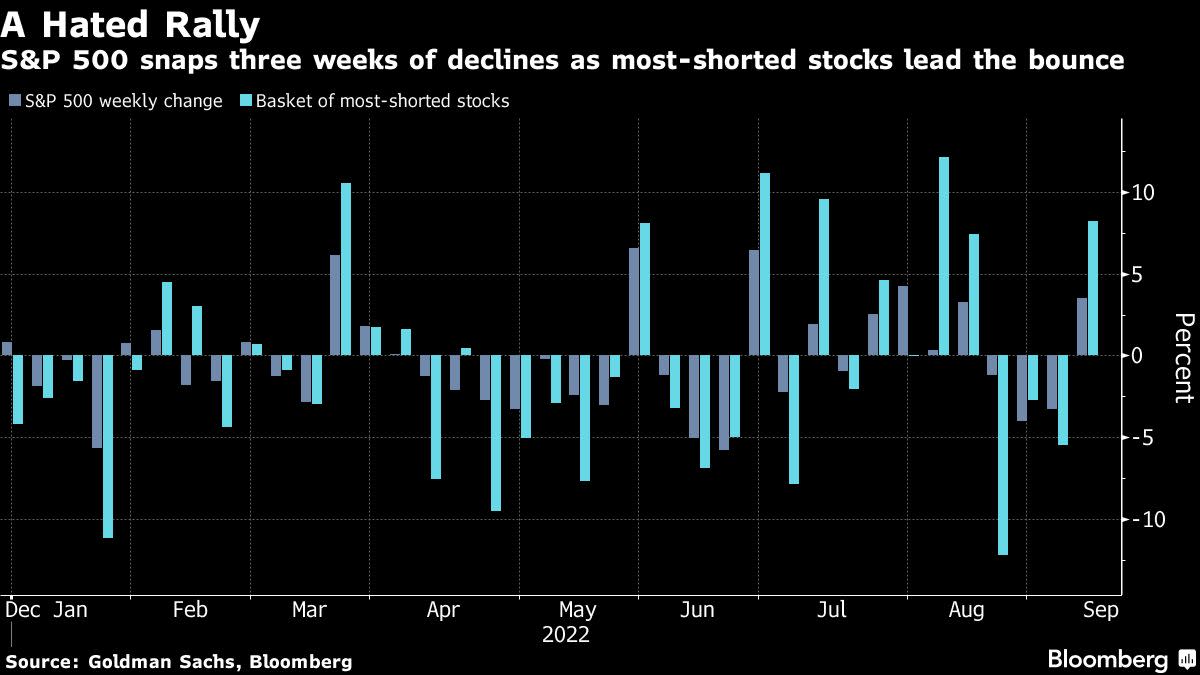
(Bloomberg) — In a week that saw discretionary buyers beat a quick retreat from risky assets, another set of traders stood up to halt a three-week plunge in the S&P 500: those with little choice but to buy.
They included short sellers, whose rush to cover lifted stocks they’re betting against to gains of more than twice the market’s. Options dealers were another bullish force after getting caught needing to boost hedges by buying stocks when they rise. Certain quantitative traders for whom chart thresholds are a call to action also made their presence known.
Combined, these players helped the market overcome a fresh wave of selling from day traders and fund investors. Up 3.7% over the holiday-shortened week, the S&P 500’s advance flew in the face of Federal Reserve Chair Jerome Powell’s persistent hawkish message. While it is debatable how much bad news is priced into 2022’s bear market, the prevailing skepticism toward stocks makes Andrew Slimmon optimistic.
“There is just a huge negative bias for the market right now and that is an extremely contrarian signal,” said Slimmon, global equity manager at Morgan Stanley Investment Management. “Markets are set up for a very good fourth quarter. There are a lot of funds betting the markets are going to drop.”
While advice not to fight the Fed has generally been sound in 2022, it has occasionally run into trouble when bearishness started to boil over. This week’s advance came at the same time when Powell said Fed officials won’t flinch in the battle to curb inflation, hardening expectations that they’ll deliver a third straight jumbo rate hike later this month. A growing number of economists see a hike of three-quarters of a percentage point as the likely outcome.
Some cited a retreat in dollar as another factor behind stock resilience given that the recent chaos in the currency market supposedly created pressure for money managers to rein in risk. Others pointed to the S&P 500’s buoyancy itself as a catalyst for further gains.
At the center of the bounce is the battle line of 3,900, which acted as a support in mid-May and then kept a lid on advances briefly in June and July. After managing to close above the threshold during a retreat Tuesday, the S&P 500 embarked on a three-day rally.
Along the way, the benchmark index reclaimed other key trendlines, including its 100-day and 50-day averages. The Cboe Volatility Index slipped for a second week in a row.
For rules-based traders, a calming market with favorable momentum is a green light to go long. Volatility control funds, for instance, snapped up $2.1 billion of stocks on Thursday alone, according to an estimate from Charlie McElligott, a cross-asset strategist at Nomura Securities International.
As the market marched higher, it turned another set of price-insensitive players into buyers: options dealers who took the other side of derivatives trade and would need to buy or sell underlying stocks to maintain a neutral market exposure. Over the week, they were mostly mired in a “short gamma” stance that requires them to go with the prevailing market trend, McElligott said.
Short sellers, whose wagers looked prescient during the 2022 bear market, were caught wrong-footed as stocks bounced back. The need to cut losses forced an unwind that led to an 8.2% jump in a Goldman Sachs Group Inc. basket of the most-shorted stocks over the week.
Technically driven demand defied the growing drumbeat of Wall Street warnings and overshadowed what’s increasingly a bearish army of fundamental-based investors. This year, cash holdings have risen in mutual funds, and hedge funds’ equity exposure hit multi-year lows.
Now, retail investors, one of the staunchest dip buyers in the post-pandemic era, are reconsidering their bullish stance. During the week through Tuesday, they sold stocks for the first time since June, according to a JPMorgan Chase & Co. estimate derived from public data on exchanges. Meanwhile, more than $10 billion was pulled out of equity funds, data compiled by EPFR Global show.
“Bears will retort that gains were held only fleetingly, and relied a great deal on short covering,” said Michael Shaoul, chief executive officer of Marketfield Asset Management. “Although a good deal of Fed tightening has been priced into the market, the stubbornness with which higher interest rates may be maintained in the face of a deteriorating economy has not been sufficiently taken into account.”
The whole year has been a dangerous one for bears and bulls alike. As alarming as Fed policy makers all sounded, inflation data due Tuesday is likely to show weakening prices from generational highs. And whatever harm rate hikes may bring, the damage has yet to make its way to corporate earnings and the credit market.
Buffeted by conflicting narratives, stock moves have made market timing all but impossible. After suffering the worst first half in five decades, the S&P 500 recouped half its bear-market decline during a two-month, 17% rally from mid-June. Once the bounce hit a wall at its 200-day average in August, the index quickly reversed its course and lost almost 10% before this week’s rebound.
The whiplash has prompted Suzanne Hutchins at Newton Investment Management to prepare for the unexpected. While having reduced overall equity holdings in anticipation of a prolonged drawdown, she recently bought bullish options as insurance.
“When you are in a long-term structural bear market, which we think we’re probably in, you do get very, very sharp market rallies,” said Hutchins, senior portfolio manager and head of the real return strategy at Newton Investment. “We’ve got call options to the upside on market should we be wrong.”
©2022 Bloomberg L.P.